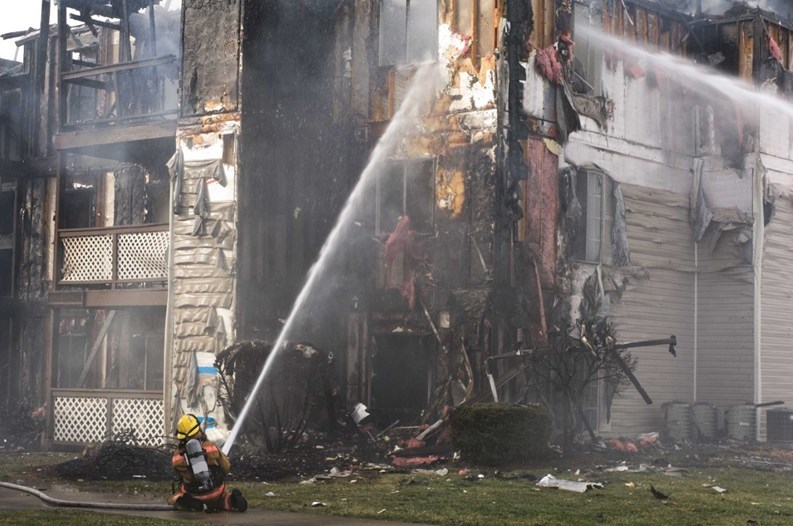One only needs to watch the news regularly to understand the devastation that a fire can have on a home or community whatever the time of year. The Lowell, Massachusetts, apartment fire last summer that killed four adults and three children has made us all especially aware of the dangers.
Fires can happen any time but certain times of year are more dangerous. “The winter months are the peak time of the year for fire deaths,” says Marty Ahrens, a manager of fire analysis services at the National Fire Protection Association (NFPA), based in Quincy, Massachusetts.
Now is an excellent time to think about association fire-safety plans.
According to a Federal Emergency Management Agency (FEMA) report published last year for the years 2009 to 2011, multi-unit dwellings were responsible for close to 30 percent of all U.S. residential fires serious enough to require a call to the local fire department. Three hundred ninety-five deaths were caused by these fires, 4,250 injuries, and $1.2 billion (yes, billion!) dollars in property loss. It's just plain old common sense to have a solid prevention and evacuation plan and make sure everyone knows the details.
Formulate a Plan
The first step in developing a fire-safety plan appropriate for your association is understanding the legal requirements. Most municipalities use some edition of the International Code Council's International Fire Code (IFC).
In general, a good fire-safety plan should include: location and coverage of building fire-protection systems; names and phone numbers of people responsible for maintaining the fire-protection equipment; names of and procedures for on-site staff responsible for reporting fires, notifying residents, giving emergency medical help and staying to take care of critical systems; evacuation procedures, including special instructions for any mobility-impaired residents; and a plan to account for all staff and residents after the evacuation. The building’s plans and drawings, both electrical and plumbing, should be kept with the plan, and everything should be on file in hard and electronic format.
Robert Solomon, a division manager with the NFPA, advises that, “The building manager should have a strategy to conduct ongoing inspection, testing and maintenance actions on the fire-protection systems. This would include the smoke alarms in the dwelling units, smoke detectors in common areas, the manual fire-alarm stations, automatic sprinkler systems and other systems or features that may be present.”
“Make sure you work with your local fire department on your plan,” says Solomon. “They are in the best position to offer ideas on how other buildings handle their plans and if they have any additional protocols such as how often the residents should be reminded of the plan or even practice the plan.”
“Since each building is unique, each plan is unique” says Solomon. For instance, “the escape planning for a low-rise condo unit is very different than the plan for a high-rise unit.” Individual facility exits must be examined. Solomon says, “Housekeeping is important. The exit doors should never be blocked, and corridors and exit stairs, including the landings, should never be used for storage. In New England, we have the added concern in the winter of making sure that snow is removed from in front of any exit doors and on the pathways and sidewalks that lead away from the building.” The NFPA website, (www.nfpa.org), he notes, offers numerous, readily available, and free resources for managers, boards and residents.
Keep track of new legislation. You may need to invest in your infrastructure to keep up to code. Newer buildings usually conform to current code, but even if your association was built recently, annual reviews are in order to stay on top of changes.
Information is Key
Both staff and residents need to know how to cooperate in prevention of fires and in response to an emergency. On-site employees must know their responsibilities—who checks safety equipment and at what intervals, who calls the fire department if needed, who alerts unit owners, who will have the roster of residents to check when everyone gets to the evacuation point, and so on.
Besides a knowledgeable staff, good communication with residents is critical to an effective fire-safety plan. Residents should be familiar with their means of egress in the event of an emergency. They should also perform monthly checks of their smoke alarms and replace the batteries twice a year at set times that are hard to forget, such as when daylight-savings starts and ends.
It’s up to management to keep unit owners in the loop as far as the safety plan is concerned. Provide the plan to all new residents as they move in as part of the orientation process. Then all occupants should be updated on a regular, recurring basis, typically annually.
Sometimes, though, getting unit owners’ attention is easier said than done. You can up your chances by using all possible channels—verbal communication at meetings, email notices, and paper, including mailings and posted information. It’s a good idea to communicate fire-safety messages on their own rather than as part of a larger package so they’re less likely to be ignored.
Critical Statistics
Russ Paulsen, executive director of Community Preparedness Programs for the American Red Cross, provides a startling number—two. “People can have as little as two minutes to escape a home fire,” he says “but most of the public thinks they have more than five minutes.” Paulsen recommends that residents “discuss their home fire-escape plan with their family, including children.” Furthermore, associations need to practice the overall plan. “Conduct fire drills with residents with a goal to get everyone to safety within two minutes, just like schools and office buildings do.”
According to the NFPA, three of five home-fire deaths occurred due to fires that began where either the smoke alarm wasn’t working or there wasn’t one at all. “Smoke alarms cut the risk of death from fire in half,” states Paulsen. “Local codes vary, but at minimum, have working smoke alarms on every floor of every unit, in and outside every bedroom.”
Besides saving lives and property, a strong prevention and evacuation plan can save money on insurance. Safety devices such as sprinklers and fire doors make a difference in rates, as do rules against cooking grills, good housekeeping of the grounds and buildings, and upgrades of electrical systems and heating systems. And of course, preventing fires means rates won’t rise due to claims.
Where It Starts
Understanding the causes of fires in multi-unit dwellings can help in their prevention. Cooking, heating equipment, smoking, electrical failure, and open flame (matches, lighters, candles) are the most common causes of fires in multi-family housing.
A startlingly high percentage —nearly 70 percent—of fires in HOAs and apartments are caused by cooking. A large proportion of these started when the cooking was untended. Residents were distracted or forgetful or even asleep. According to the National Fire Protection Association, 43 percent of people who have died in cooking fires were asleep at the time.
Association managers might want to communicate these statistics to residents and encourage them to be especially vigilant when cooking. Remain in the kitchen if at all practical and, even if that stew or pot of beans is on a very slow simmer, do not nap.
“Though cooking is the leading cause of fires in multi-family homes, smoking is still the leading cause of home-fire deaths overall, and that’s an important distinction,” says Ahrens. “Something else that we are seeing in general is that more and more homes are not allowing smoking inside. I don't know about your neighborhood, but I go out even in the winter and see a lot of people smoking on their balconies or their steps.” Depending on the structures they control, association management and boards can often make their buildings safer by providing non-flammable containers where residents can discard smoking materials. Ahrens says, “It’s really important to make sure that there are safe places to dispose of cigarettes outside—not in the mulch, not in the potted plants.”
A dramatic condominium fire is more likely to make the news than an individual house fire, and such coverage can heighten fear of a conflagration, but you may actually be safer in a multi-family home than in a house. “There is a lower death rate in apartments than in one- or two-family homes. Seventy-one percent of the home-structure fires were in one or two-family homes, but that accounted for 84 percent of the home-structure deaths,” says Ahrens.
One reason is heating systems. “The equipment that is managed centrally is less of a problem in terms of causing fires in multi-family housing than it is in one- or two-family housing. In one- and two-family homes, you’re free to a large degree to do what you want,” Ahrens explains.
In addition, says Ahrens, “The codes and the professional oversight play a big role in the multi-family housing.” Regulations that mandate such life savers as smoke detectors do make a difference.
Keith Loria is a freelance writer and a frequent contributor to New England Condominium. Staff writer Judy Hill contributed to this article.







Leave a Comment